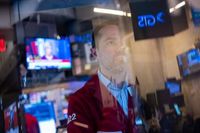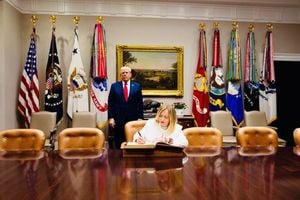Markets across the globe experienced significant volatility on Friday, April 11, 2025, as the escalating trade war between the United States and China continued to rattle investors. In a dramatic turn of events, China announced a hike in its retaliatory tariffs on U.S. imports to a staggering 125%, pushing U.S. stock futures higher after a tumultuous week of trading.
The latest tariff increase came just two days after President Donald Trump indicated that China would be excluded from his 90-day pause on tariffs, leading to heightened anxiety among investors. Beijing's decision to raise its levy on U.S. imports from 84% was met with immediate repercussions in the markets, as traders braced for further escalation in trade tensions.
On Wall Street, the S&P 500 index opened with a small drop but ultimately climbed about half a percent higher, reflecting a broader recovery in stocks. This rebound marked the index's best weekly gain since 2023, following a selloff in longer-term Treasuries that had created a sense of uncertainty in the market. The S&P 500 jumped approximately 1.5% on the news that a Federal Reserve official indicated the central bank was prepared to intervene to stabilize markets if necessary.
Despite the positive movement in stocks, the Stoxx Europe 600 index slipped about 0.2% on the same day, reflecting the mixed sentiment in European markets. Analysts noted the ongoing volatility as a sign of a "confidence crisis" in the U.S. dollar, which has lost some of its appeal as a safe haven for investors amid the shifting trade landscape.
The dollar plunged against most major currencies, falling about 1% to its lowest level in three years, while the euro climbed more than 1% against the dollar, reaching $1.13. This decline in the dollar has been interpreted by some analysts as a barometer indicating a growing sentiment to "sell America" as uncertainties surrounding U.S. economic policies unfold.
Meanwhile, gold prices soared above $3,200 per troy ounce for the first time, as investors sought refuge in the precious metal amid fears of escalating trade tensions. The price surge underscores a shift in market sentiment as traders look for safer assets in light of recent developments.
In Asia, stocks reacted differently to the news. The Nikkei 225 in Japan dropped 2.9%, while stocks in Hong Kong rose 1.6%, and those in mainland China increased by 0.4%. Taiwan's market also saw a rise of 2.8%. These mixed results highlight the varying impacts of the trade war on different regions.
The volatility in the markets has been exacerbated by President Trump's erratic trade policy announcements. Just a day prior, on April 10, 2025, the S&P 500 index had suffered a sharp decline of 3.5% after the Trump administration clarified that tariffs on Chinese imports would total 145%, contrary to earlier statements suggesting the rate was 125%. This back-and-forth has left investors uncertain about the future direction of U.S.-China trade relations.
Traders are now looking to the VIX index, known as Wall Street's fear gauge, which has surged to levels not seen since the early days of the coronavirus pandemic in March 2020. This spike indicates that investors are bracing for continued volatility in the markets as they assess the potential fallout from the ongoing trade conflict.
As the situation develops, market analysts are closely monitoring the bond market as well. On April 11, the 10-year U.S. Treasury yield rose above 4.4%, the highest level since February, as bonds typically regarded as safe havens lost value amid the turmoil. This unusual scenario has left traders puzzled, with some speculating that heavy losses in the stock market could be driving investors to liquidate their bond holdings.
Jamie Dimon, CEO of JPMorgan Chase, expressed concerns regarding the rising Treasury yields, stating that his bank is monitoring the bond market closely. The current market conditions have prompted discussions about the sustainability of U.S. assets, as analysts at Deutsche Bank noted that the dollar's historic weakening may indicate a reassessment of the premium that U.S. assets have traditionally enjoyed.
Looking ahead, investors are left to wonder how the trade war will unfold and what further implications it will have on global markets. The uncertainty surrounding President Trump's trade policies continues to loom large, as the situation remains fluid and unpredictable. With tensions between the U.S. and China showing no signs of abating, traders are bracing for more volatility in the days and weeks to come.
As the markets close on this tumultuous week, the question remains: how will the ongoing trade conflict shape the economic landscape in the months ahead? Investors are keenly aware that the decisions made in Washington and Beijing will have far-reaching consequences, not just for their portfolios, but for the global economy as a whole.






